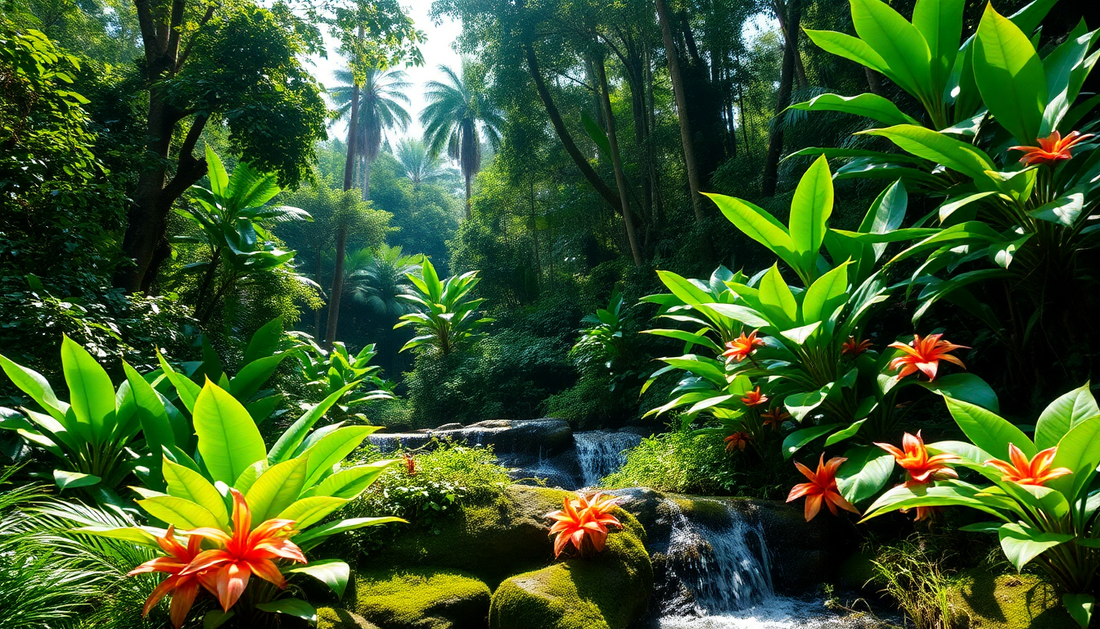
Thriving in the Rainforest: A Guide to Caring for Plants in Humid Environments
Share
As the world becomes increasingly urbanized, many of us find ourselves longing for a touch of nature in our daily lives. Whether you live in a bustling city or a more temperate climate, bringing the lush, verdant beauty of the rainforest into your home can be a rewarding and enriching experience. However, caring for plants in rainforest-like conditions requires a unique approach, as the high humidity, abundant rainfall, and intense sunlight can present a unique set of challenges.
In this comprehensive guide, we'll explore the best practices for nurturing your plants in a rainforest-inspired setting, ensuring they thrive and bring a touch of tropical splendor to your indoor oasis.
Understanding the Rainforest Ecosystem
The rainforest is a complex and dynamic ecosystem, characterized by its warm, humid climate, abundant rainfall, and diverse array of plant and animal life. This unique environment poses both opportunities and challenges for the home gardener.
Temperature and Humidity
Rainforests are known for their consistently warm temperatures, with average temperatures ranging from 20°C to 30°C (68°F to 86°F) throughout the year. The high humidity, often exceeding 80%, is another defining feature of the rainforest climate. This combination of warmth and moisture creates an environment that is ideal for many tropical and subtropical plant species.
Lighting Conditions
Rainforests are renowned for their lush, verdant canopies, which filter the intense sunlight and create a dappled, diffused lighting pattern on the forest floor. This low-light environment is well-suited for many shade-loving plants, but can also present challenges for species that require more direct sunlight.
Soil and Nutrient Cycling
The soil in rainforests is typically nutrient-rich, thanks to the rapid decomposition of organic matter and the constant cycling of nutrients through the ecosystem. However, the high rainfall can also lead to nutrient leaching, requiring gardeners to supplement their plants' needs with appropriate fertilizers.
Selecting the Right Plants
When choosing plants for your rainforest-inspired indoor garden, it's important to select species that are well-suited to the high-humidity, low-light conditions. Some of the best options include:
Tropical Foliage Plants
- Philodendrons
- Monstera deliciosa
- Calathea
- Alocasia
- Anthurium
Epiphytic Plants
- Orchids
- Bromeliads
- Air plants (Tillandsia)
Ferns
- Boston fern
- Maidenhair fern
- Staghorn fern
Flowering Plants
- Begonias
- Gesneriads (African violets, gloxinias)
- Impatiens
By carefully selecting plants that thrive in rainforest-like conditions, you can create a lush, vibrant indoor oasis that captures the essence of the tropical wilderness.
Optimizing Growing Conditions
To ensure your plants flourish in the rainforest-inspired environment, it's essential to replicate the key elements of their natural habitat as closely as possible. This includes:
Temperature and Humidity Control
Maintain a consistent temperature range of 20°C to 30°C (68°F to 86°F) and aim for a humidity level of 60% to 80%. You can use a combination of humidifiers, misting systems, and strategic placement of your plants to achieve the desired conditions.
Lighting Considerations
Provide your plants with bright, indirect light, mimicking the dappled sunlight of the rainforest canopy. Avoid direct, intense sunlight, which can scorch delicate leaves. Consider using grow lights or positioning your plants near north-facing windows to ensure they receive the appropriate amount of illumination.
Soil and Watering
Use a well-draining, nutrient-rich potting mix specifically formulated for tropical plants. Water your plants regularly, keeping the soil consistently moist but not waterlogged. Avoid letting the soil dry out completely, as this can be detrimental to your plants' health.
Fertilization
Supplement your plants' nutrient needs with a balanced, water-soluble fertilizer formulated for tropical or indoor plants. Apply the fertilizer according to the manufacturer's instructions, typically every two to four weeks during the growing season.
Pest and Disease Management
Vigilantly monitor your plants for signs of pests or diseases, as the warm, humid conditions can be conducive to their proliferation. Regularly inspect your plants and take swift action to address any issues, using organic or natural pest control methods whenever possible.
Maintaining a Thriving Indoor Rainforest
Creating and maintaining a thriving indoor rainforest requires a combination of careful planning, attentive care, and a bit of patience. By following these best practices, you can transform your living space into a lush, verdant oasis that brings the beauty and serenity of the tropical wilderness right into your home.
Proper Potting and Repotting
Choose the right-sized pots for your plants, allowing for adequate root growth and drainage. Repot your plants every one to two years, or when they become root-bound, to ensure they have the necessary space and nutrients to thrive.
Pruning and Grooming
Regular pruning and grooming can help maintain the aesthetic appeal of your indoor rainforest. Trim away any dead or damaged leaves, and prune back overgrown plants to encourage bushier growth and prevent them from becoming leggy.
Misting and Humidity Maintenance
Regularly misting your plants with a fine water spray can help increase the humidity around them, mimicking the natural precipitation of the rainforest. Additionally, consider using a pebble tray or placing your plants on a humidity-retaining surface to further boost the moisture levels.
Rotation and Rearrangement
To ensure even light exposure and prevent your plants from becoming etiolated (stretched out due to insufficient light), rotate or rearrange them periodically. This will help maintain the lush, vibrant appearance of your indoor rainforest.
Monitoring and Troubleshooting
Closely observe your plants for any signs of stress or disease, and address issues promptly. Be prepared to adjust your watering, lighting, or fertilization regimes as needed to keep your indoor rainforest thriving.
By embracing the unique challenges and opportunities of creating an indoor rainforest, you can transform your living space into a verdant, serene oasis that brings the beauty and tranquility of the tropical wilderness right into your home. With the right plants, the proper growing conditions, and a touch of dedicated care, you can cultivate a thriving indoor rainforest that will delight and inspire you for years to come.
